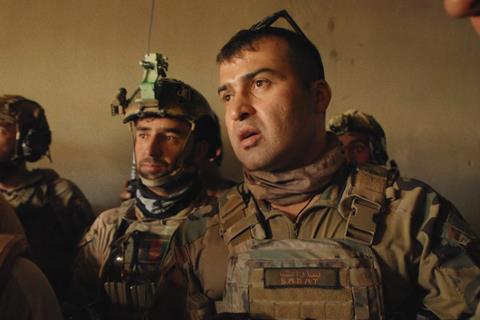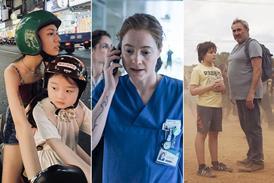The US filmmaker talks about the fear and the follow-up to America’s chaotic withdrawal from Afghanistan

After exploring the Mexican drug wars (Cartel Land), Isis in Syria (City Of Ghosts) and a hospital battling the Covid crisis (The First Wave) among a long list of harrowing subjects, Oscar-nominated, six-time Emmy Award-winning director Matthew Heineman put himself back into the line of fire to capture the final months of America’s 20-year war in Afghanistan in his 2022 documentary Retrograde, which is nominated for six Primetime Emmys this year.
Produced and distributed by National Geographic, the emotionally-charged, on-the-ground account of the war’s abrupt end is told through multiple perspectives as it seeks to put a human face on the traumatic, chaotic exodus from the country.
The prolific filmmaker spoke to Screen about controlling the narrative amidst a world in chaos and why the aftermath of America’s war in Afghanistan didn’t end when the final credits rolled on Retrograde.
Can you talk about your original intent for Retrograde and how it changed course?
We started out trying to document the final US deployment to Afghanistan. We spent years trying to get access to the US military and specifically the special operations community. We finally got access to the Green Berets – and then Covid happened. By the time we deployed with them, it became clear that maybe we could tell the story about the final chapter of this decades-long war through the prism of this deployment, so that’s what we thought the film would be.
Then several months into filming, President Biden decided to pull out our troops, so we were left with this question of: “What is this story that we’re telling?” I reached back out to Afghan General Sami Sadat, who had previously partnered with the Green Berets we were filming, and asked him: “Would you be open to us coming back and filming whatever this next chapter may be through your eyes?” He said yes and we ended up staying with him until the fall of the country.
What were the conditions like on the ground?
I shoot myself and I had two amazing DPs with me: Tim Grucza and Olivier Sarbil. For me, the only way to get intimate verité like that is to have a very small footprint. My goal is to become part of the fabric of the daily lives of the participants. We were filming every day from the time General Sadat woke up to the time he went to bed.
Can you talk about shooting the scenes of the exodus at the Kabul airport?
As we descended into Kabul, the pilot was told on the intercom that we couldn’t land because a plane on the tarmac was blocking the runway, which was actually the president of Afghanistan fleeing. We circled for an hour until the pilot took us back to Dubai. I was devastated. We’d been building the story for months, and this tragic historic day I was now watching on a hotel TV screen. I thought it was the greatest journalistic failure of my entire career. I spent every waking hour figuring out how to get back into the country, which we did several days later.
How did this turn of events shift the storyline once again?
When we landed, General Sadat had already been forced to flee so we were left with the question: what story are we telling? Our main protagonist was gone.With every door that closes, another door opens; with every failure comes an opportunity. It allowed me to expand the metaphorical aperture of the film, to see all of the Afghan citizens that General Sadat and the Green Berets had been fighting for and this horrible, desperate, chaotic, awful exodus that was happening as the final coda to a two decades-long war.
What was it like to be there and filming those final days?
It was the most difficult moment of my career. I’ve cried a fair amount in edit rooms and at screenings and other times along the production journey of a film, but I’ve never actually cried while filming. In that scene at the gate, when thousands of Afghan civilians and American partners we left behind were crammed like sardines in a four-foot sewage ditch as the Taliban was watching from 100 yards away at gunpoint and as Isis was circling in suicide vests waiting to attack unbeknownst to us, it was surreal and devastating. All I could think about was, “How did we get here? Is this really how this is ending?” I had tears streaming down my face. I kept having to wipe the viewfinder down.
Is there one image that stands out from that moment?
The image we end the film with is the image that is burned into my memory forever, that of a young woman with her hands on the metal gate staring down at the US soldiers. She writes a novella for us in those 46 seconds: fear, trepidation, anger, the weight of the country plays out on her face in that moment. Faces speak so loudly. US soldiers were not allowed to voice their opinion of President Biden’s decision to pull the troops, but their faces spoke volumes. I love shooting based on emotion, because the human face doesn’t lie – people lie. So it creates a really intimate connection.
You were shooting in the middle of a war zone. You’re no stranger to putting yourself in danger, but what were some of the scariest moments for you?
There were plenty of terrifying moments, like being in a Black Hawk helicopter on multiple resupply missions attempting to reach towns surrounded by the Taliban who were shooting RPGs at us. I had no agency in that situation – I have no ability to fly a helicopter and couldn’t press the eject button or go home. It was so loud and so chaotic, I knew something was wrong as the helicopter dipped and dove and I could tell they were in some sort of firefight. In those situations, all I can control is my camera, so I choose to concentrate on focusing, on aperture and framing, making sure the record button is on, holding my camera steady.
How do you want audiences to feel when they leave this film?
I don’t like putting things on a platter for people. I hope my films play on many different levels and that 1000 different people take away 1000 different things. If there is any goal I have, it’s to engage the world to care a little bit more, to be a little bit more empathetic about issues that are important to our time.
Since the final credits on the film have rolled, what have been the off-screen developments? What is the epilogue?
It’s just a devastating situation. All the gains that were made have been eradicated. Girls can’t go to school, women can’t go outside without their faces covered. Society has “retrograded” back to where it was 20 years ago. This cycle is really sad. We’re now back to where we started, and for what?
Yet Retrograde is still streaming and nominated for six Emmys, perhaps shifting awareness once again back onto Afghanistan?
There are still thousands and thousands of American partners who fought alongside Americans, who were paid by Americans, who bled and died alongside Americans who are stuck in the country desperately trying to flee. Among many things, I hope the film helps to create awareness for the country that we left behind, the people that we left behind. I hope that this film and maybe in some small way these nominations, help put Afghanistan a bit more into the zeitgeist and into the conversation.























No comments yet